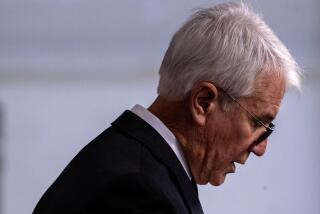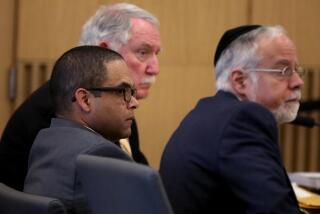Penn Case Testimony Questions Extent of Glare
- Share via
The prosecution Friday discredited a defense photo introduced to show that the glare on the front window of a police car prevented Sagon Penn from seeing that the woman in the car was not a police officer.
Penn is on trial for killing police officer Thomas Riggs and wounding officer Donovan Jacobs and ride-along Sarah Pina-Ruiz.
The testimony Friday of land surveyor Allan Arnson, a defense expert witness, addressed a critical issue in the murder trial. Defense attorney Milton Silverman has argued that Penn, 24, shot civilian ride-along Pina-Ruiz because he believed that she was an officer sitting in the passenger side of the police car. Silverman said that the setting sun was reflecting off the window in such a way that all Penn could see of the woman was a blurry shadow.
Arnson was called as an expert witness by Silverman because his job requires precise knowledge of the position of the sun and horizon to accurately survey an area. Before advances in technology, surveyors relied exclusively on the sun’s position and fixed points when surveying land.
Silverman and prosecutor Michael Carpenter agree that sunset was at 6:08 p.m. on March 31, 1985, the day of the shootings. Penn, who is black, said that he acted in self-defense when the two white officers used racial slurs and beat him with fists and batons. Both attorneys agree that the shootings occurred at about 6:14 p.m., after the sun had set.
In a photo taken on April 16, 1985, Silverman said the defense used precise police measurements to recreate the place and time of the shooting. A second photo taken by defense investigators on April 3, 1986, also purports to recreate the scene, including the time where the sun would have been on the day of the incident.
However, in both photos the sun is clearly visible, reflecting from the bottom of the windshield of the police car.
Although Arnson only testified about the 1985 photo, he said that if the scene and time of the incident were accurately re-created, the sun would not be visible in the photo.
“So, the defense exhibit is inaccurate,” Carpenter said.
“That’s correct,” Arnson said.
The issue was muddled further when Silverman pointed out that a police investigator who re-created the scene on April 2, 1985, two days after the shootings, testified that the April 16, 1985, defense photo is an accurate re-creation.
“You’ve already got a photo that has been identified by Detective (Gary) Murphy,” Silverman said. “He says, ‘That’s pretty close to what I could see.’ ”
But Murphy also testified that his re-creation proved that Penn could clearly distinguish that Pina-Ruiz was not a police officer but an unarmed civilian. And under a vigorous cross-examination by Silverman, Murphy also admitted that his re-creation of the scene was sloppy and not scientific at all.
Despite contradictions surrounding the accuracy of the two defense photos, Superior Court Judge Ben W. Hamrick allowed both of them to be introduced as evidence.
On Friday, Silverman said he would like to have the jury visit the scene of the shootings. Carpenter did not object but expressed reservations about the visit because the scene has changed in the past 13 months.
Silverman acknowledged that there have been some changes, particularly in the driveway in the Encanto neighborhood where the shootings occurred. Hamrick did not rule on the matter, and instead instructed the two attorneys to work out any differences they may have about a jury visit to the scene and report back to him.
Hamrick is also expected to rule next week on a defense motion to include a taped confession by Penn taken by police about 30 minutes after the shooting.
Carpenter wants the confession excluded, calling it “self-serving.” Silverman claims that the confession contains exculpatory material and wants the jury to hear the confession.
More to Read
Sign up for Essential California
The most important California stories and recommendations in your inbox every morning.
You may occasionally receive promotional content from the Los Angeles Times.













